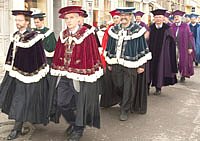Contact
International Office
phone: Tel: +49 345 55 21590
fax: Fax: +49 345 55 27427
info@international.uni-hall...
Universitätsring 19/20
06108 Halle (Saale)
postal address:
Martin-Luther-Universität Halle-Wittenberg
International Office
D-06099 Halle (Saale)
History of the University

Today’s Martin Luther University Halle-Wittenberg – as already shown by its name – has two historical roots. One comes from the Saxon Prince-Elector, Frederick the Wise, who opened Leucorea University in Wittenberg in 1502, where important scholars such as the reformers Martin Luther and Philip Melanchthon taught. Through their efforts, the city and its university developed into the intellectual centre of the Reformation.
The other root is from the Fridericiana University, established in Halle in 1694. In its time, it was well-known far beyond the country’s borders. Because of personalities, such as the lawyer Christian Thomasius and the philosopher, Christian Wolff, it was one of the sources of the German Enlightenment. In the year 1817, the universities of Wittenberg and Halle merged; henceforth, there was no longer any teaching done in Wittenberg. The university in Halle then received the name “United Frederick University“.
The special characteristic of the two-origin university can be found today in the symbolic expression of the double seal of Martin Luther University Halle-Wittenberg.
In the 19th and early 20th centuries, the university in Halle gained an exceptional reputation as a place of research and teaching. It stood as an equal next to old universities such as Tübingen, Heidelberg, Jena, Leipzig, and Göttingen. It received its current name, “Martin Luther University Halle-Wittenberg,” on November 10, 1933.
The long, varied history of the university is also reflected in the architecture of the cityscape; many academic departments are accommodated in historic buildings. However, in the last few years, numerous university buildings have been comprehensively renovated and equipped with the most advanced technology and equipment. Modern standards of teaching and research, as well as long-standing traditions, are found in all areas of this university.
Since the reunification of Germany, in the year 1989, not only has the exterior of the university changed, but its faculty, staffing and administration have also been renewed with a democratic foundation. Since the early ‘90s, over 300 professorships have been filled. More than half of the faculty, therefore, are comparatively young. The contact between instructors and students is quite close, because large class sizes are rare – a fact which students studying at Martin Luther University appreciate.



